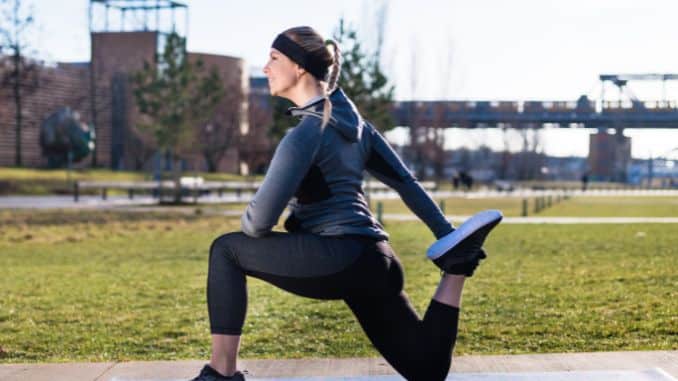The human body functions as an intricate system of interconnected muscles, each contributing to the flexibility and functionality essential for daily activities, with exercises like the Rectus Femoris Stretch playing a crucial role.
Among these, the rectus femoris muscle is pivotal in lower body movement. This article aims to emphasize the importance of the rectus femoris muscle, shedding light on its integral role.
Additionally, it will provide insights into practical and effective stretching techniques tailored to alleviate tight muscles.
By understanding and prioritizing the care of the rectus femoris, individuals can enhance their overall physical well-being and optimize the performance of this critical component in the complex musculoskeletal network.
What Is The Rectus Femoris Muscle?

The rectus femoris is a crucial muscle in the quadriceps group [¹], located in the front of the thigh. It plays a key role in knee extension activities like running, jumping, and kicking and also assists in flexing the hip.
This muscle originates from two points and attaches to the patella, also known as the kneecap, via the quadriceps tendon. Conditions such as active and passive insufficiency can hinder its function.
- Active Insufficiency the rectus femoris attaches to the patella [²] occurs when the rectus femoris is shortened too much (like a straight knee), limiting hip flexion ability.
- Passive Insufficiency happens when the muscle is maximally stretched at both joints, hindering its force generation during knee extension.
Understanding these limitations is key to optimizing exercise and preventing injury. Developing from the mesoderm in the embryo, the rectus femoris is nourished by the femoral artery and controlled by the femoral nerve.
The seemingly straightforward structure of the rectus femoris can sometimes present with variations. Though not always detrimental, these variations can affect the muscle's function and increase susceptibility to injury.
Some examples include:
- Number of origins: The rectus femoris might have a single or double head at its proximal (upper) attachment point. This variation usually doesn't cause problems but can be relevant during surgery or imaging interpretation.
- Muscle belly variations: In rare cases, the muscle belly might have an extra slip or show minor anatomical differences.
Injuries are another concern for the rectus femoris, especially for athletes or those involved in activities that demand repetitive hip flexion and knee extension.
Common Injuries
- Muscle Strains: involve tearing muscle fibers, ranging from mild (microtears) to severe (complete ruptures). Pain, weakness, and bruising are typical symptoms.
- Tendonitis: This is inflammation of the tendon connecting the muscle to the bone, often at the kneecap or hip. Pain, especially with activity, and tenderness are common signs.
- Tears: Complete muscle or tendon tears can be debilitating and require medical attention.
Diagnosis And Treatment
Early diagnosis of any abnormality or injury is crucial for a smooth recovery.
Here are some valuable tools used for assessment:
- Ultrasonography (ultrasound): This non-invasive imaging technique uses sound waves to create real-time images of the muscle, revealing tears, inflammation, and other abnormalities.
- Magnetic Resonance Imaging (MRI): This powerful imaging technique creates detailed cross-sectional pictures of the muscle and surrounding tissues, offering a more comprehensive view of potential damage.
By understanding structural variations and potential injuries and using diagnostic tools, healthcare professionals can create a targeted treatment plan for the rectus femoris. This might involve rest, physical therapy, medication, or even surgery in severe cases.
Where Is Rectus Femoris Located?
The rectus femoris muscle, located in the superior, anterior, and middle compartments of the thigh, is unique among the four quadriceps muscles as it crosses the hip joint. This allows it to facilitate both hip flexion and knee extension.
It attaches to the patella, aiding in thigh flexion at the hip and leg extension at the knee. Alongside the vastus medialis and other quadriceps muscles, it plays a crucial role in maintaining knee stability and supporting various leg movements.
The femoral nerve innervates it and contributes to hip flexion when the knee is extended. However, its efficacy in knee extension diminishes when the hip is flexed.
Due to its involvement in dynamic actions like sprinting, jumping, and kicking, the rectus femoris is prone to strains and injuries, including the risk of avulsion fractures at the hip.
Why Does My Rectus Femoris Muscle Hurt?
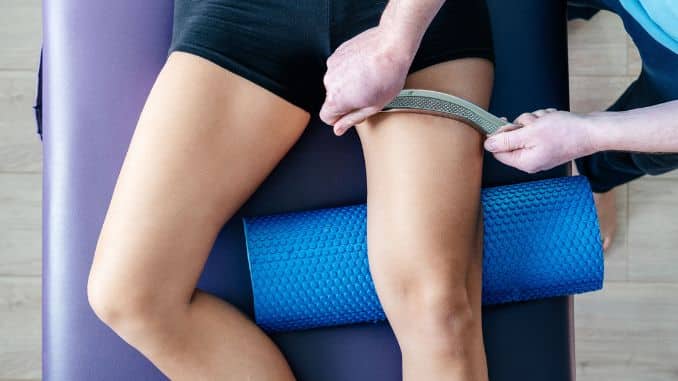
Rectus Femoris Muscle is crucial in flexing the thigh at the hip and extending the knee. However, excessive use and repetitive activities [³] can cause strain and injury in this muscle.
Athletes participating in sports that involve repetitive jumping and kicking, such as volleyball, are particularly prone to developing issues with the rectus femoris muscle. This overuse problem can result in tearing, stress, and stretching of the muscle and its tendon.
Symptoms of rectus femoris muscle strain may include:
- Sudden sharp pain.
- Bruising at the site of injury.
- Pain upon palpation.
- Difficulty straightening and knee pain.
Treatment typically involves rest, ice, NSAIDs, physical therapy, and injections. In more severe cases, an MRI may be necessary to assess the extent of the injury.
Understanding The Benefits Of The Rectus Femoris Stretch
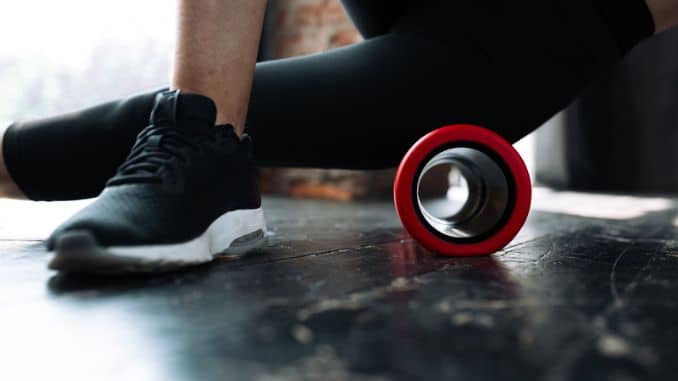
Engaging in activities such as running, jumping, sitting for long periods, or participating in certain sports can cause tight rectus femoris muscle and strain. If left untreated, this tightness can lead to pain and discomfort in the knee, hip, and lower back. Regular stretching of the rectus femoris is essential for maintaining flexibility and mobility.
By incorporating stretches such as standing, kneeling, seated, sitting butterfly, and standing figure four stretches, individuals can increase their mobility, reduce fatigue, and prevent injury. It is essential to prioritize stretching and strengthening this muscle to ensure overall body health.
Best Rectus Femoris Stretch
Discovering the most effective stretches for the rectus femoris is essential for achieving optimal results. We'll discuss and demonstrate the top stretches to target this muscle and enhance its flexibility.
1. Standing Quadriceps Stretch
Firstly, begin in an upright standing position, maintaining good alignment with your head, shoulders, and hips. Therefore, engage your core, bring your heel up against your back, and hold your foot with your hand. After that, hold this position for 5-10 seconds. Lastly, return to the starting position and repeat the movement on the opposite side.
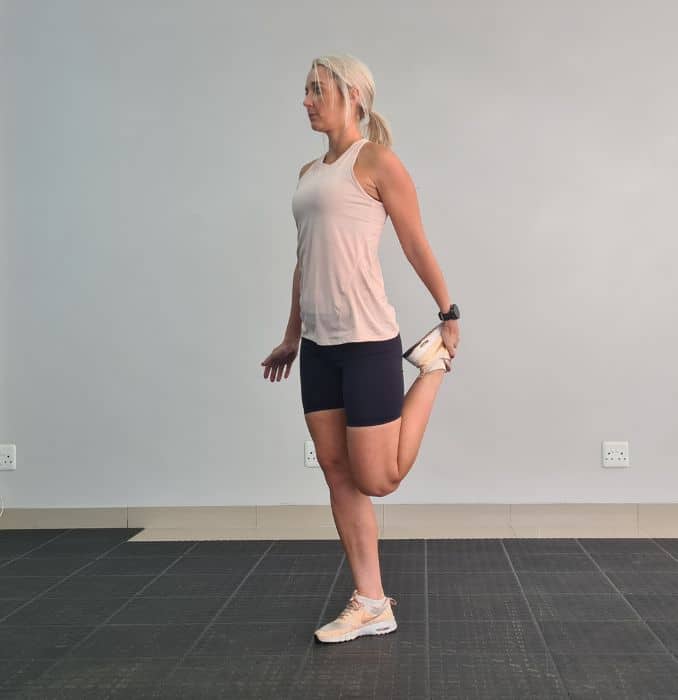
2. Kneeling Hip Flexor Stretch
Begin in an upright standing position maintaining a good alignment with your head, shoulder, and hips. Afterwards, step forward and kneel with the front leg at 90 degrees, your foot flat on the floor, and your ankle, knee, and hips at a 90-degree angle. Furthermore, the back portion is 90 degrees when looking at the hip, knee, and ankle. Moreover, engage your core and glutes and bring the hips forward. Lastly, hold this position for 5-10 seconds. Return to the starting position and repeat the movement on the opposite side.
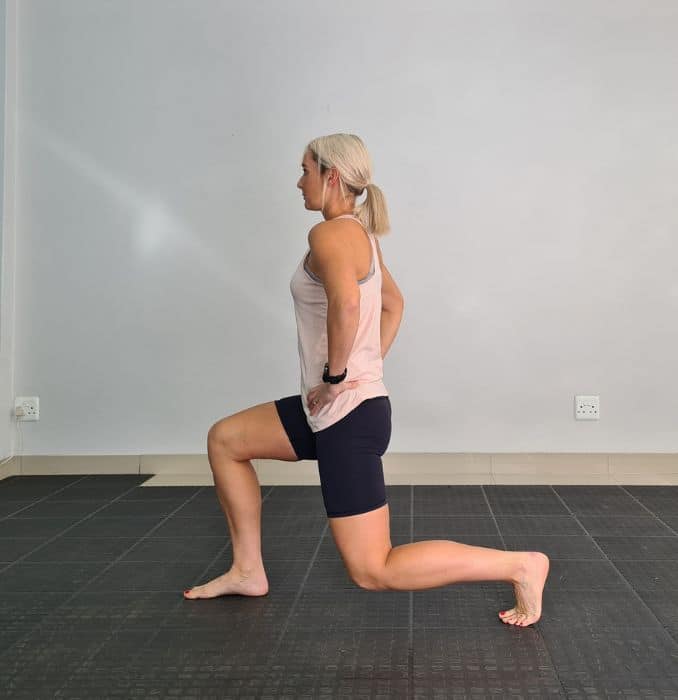
3. Side Lunge
Firstly, begin in an upright standing position with your feet wider than shoulder-width apart, maintaining good alignment with the head, shoulders, and hips. Moreover, place your hands on your thighs. Afterwards, engage your core and shift your body weight to one side while extending your opposite leg. Therefore, return to the starting position and repeat the movement on the opposite side. Lastly, start with 1 set of 10 repetitions on each side.
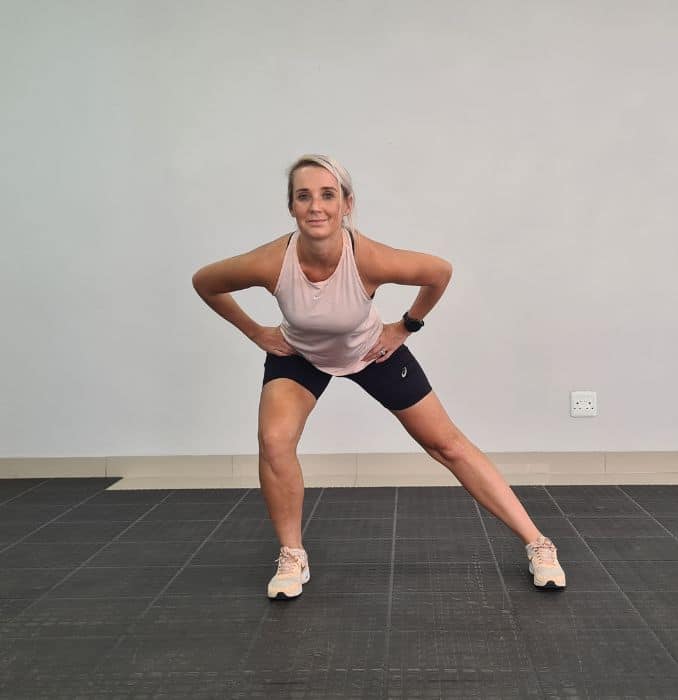 |
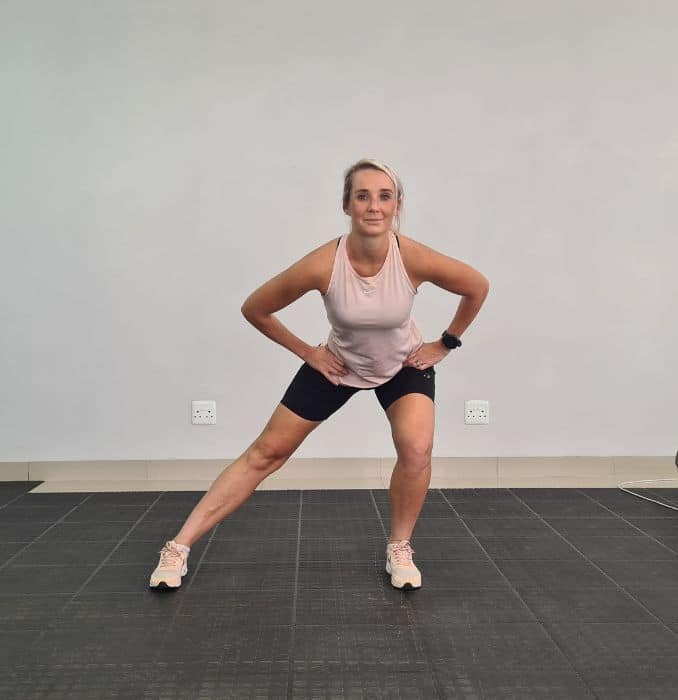 |
4. Seated Knee-to-Chest Stretch
You may utilized a chair for this exercise
Begin in an upright sitting position on a chair with your feet shoulder-width apart, maintaining a good alignment with your head, shoulders, hips, and legs. Furtheremore, engage your core and lift your knee, bringing your knee ideally to chest height, and grab your foot with both hands. Afterwards, hold the position for a couple of seconds. Return to the starting position and repeat the movement on the opposite side. Lastly, start with 1 set of 10 repetitions on each side.
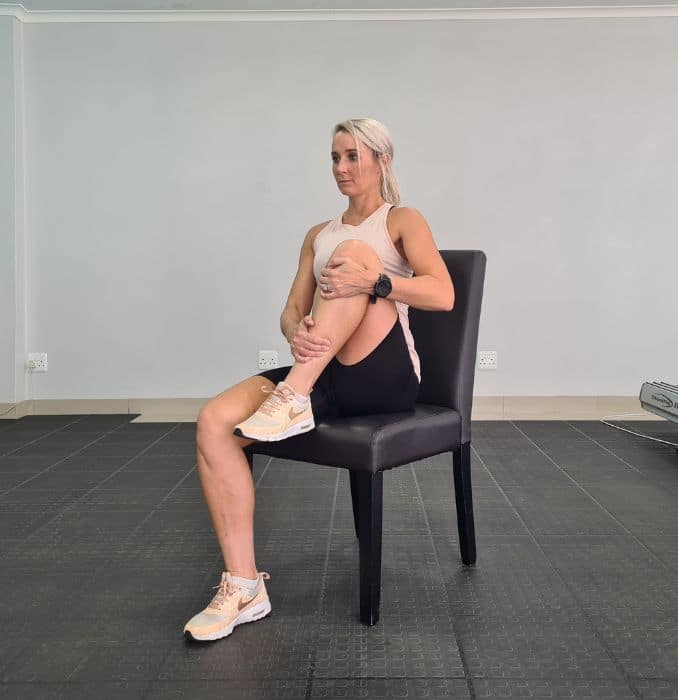 |
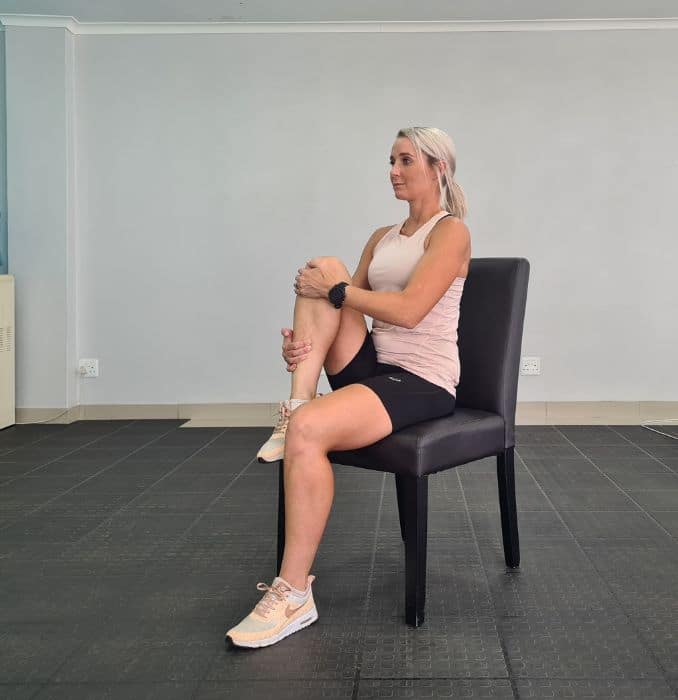 |
5. Pigeon Pose
Firstly, begin in a four-point position on the floor. maintaining a good alignment with your head, shoulders, hips, and legs. Moreover, engage your core, bring one leg up and across your hip and lean forward. Furthermore, hold this position for 5-10 seconds. Lastly, return to the starting position and repeat the movement on the opposite side.
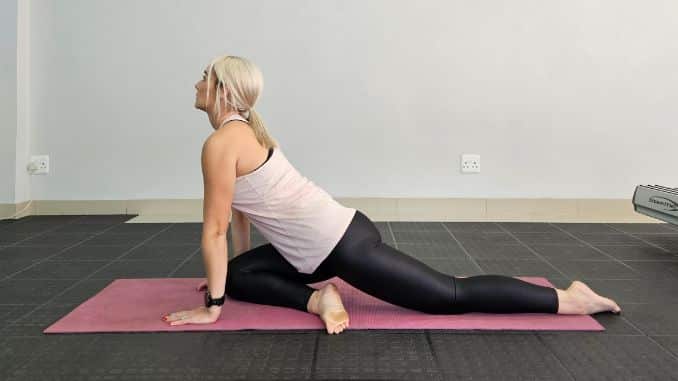 |
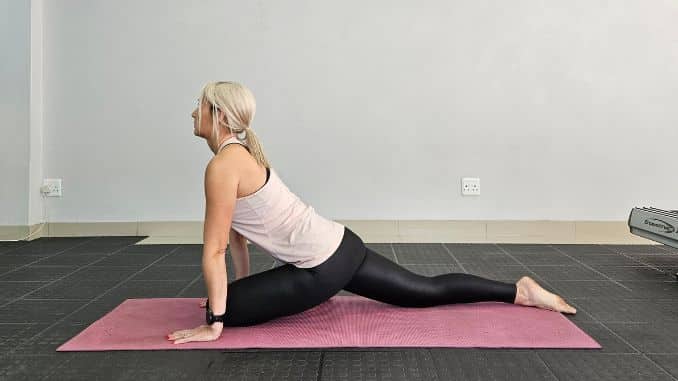 |
Common Mistakes To Avoid When Performing The Rectus Femoris Stretch
To ensure safety and effectiveness when stretching the rectus femoris, be aware of these common mistakes:
- Overstretching: Avoid pushing too far into the stretch to prevent muscle strains and injuries.
- Poor Posture: Maintain proper alignment with a straight back and squared hips to ensure effective stretching and avoid undue stress.
- Rushing Through the Stretch: Move slowly, holding each stretch for 20-30 seconds to allow muscle fibers to relax and lengthen.
- Not Warming Up: Warm up with light cardio before stretching to prevent injury from cold muscles.
- Holding Your Breath: Breathe deeply and consistently to oxygenate the muscles and promote relaxation.
- Ignoring Pain Signals: Stop if you experience sharp or intense pain; pain signals that something may be wrong.
- Inconsistency: Regularly stretching to increase flexibility and avoid muscle imbalances or injuries.
- Using Incorrect Foot Position: Position your foot correctly during kneeling or standing stretches to avoid knee joint stress and joint pain, as well as ensure the muscle is targeted effectively.
By avoiding these common mistakes, you can perform the rectus femoris stretch more safely and effectively, aiding in injury prevention and flexibility improvement.
Conclusion And Final Thoughts On Mastering The Rectus Femoris Stretch Technique
Mastering the rectus femoris stretch technique is vital for individuals with knee osteoarthritis, as multiple studies have demonstrated its benefits. These stretches help reduce pain, enhance range of motion, and improve gait parameters.
The exercises are simple and can be done at home, making them widely accessible. Results from randomized controlled trials have shown significant improvements in pain intensity and spatiotemporal gait parameters when these stretches are combined with other exercises.
Regularly incorporating rectus femoris stretches into an exercise routine can greatly improve the quality of life and overall function of those with knee osteoarthritis.
Are you tired of knee pain holding you back from your favorite activities? It's time to take action and strengthen your knees with simple, effective movements! Introducing our guide: “10 Easy Movements for Stronger Knees” a comprehensive resource designed to help you build strength, improve flexibility, and enhance overall knee health.

